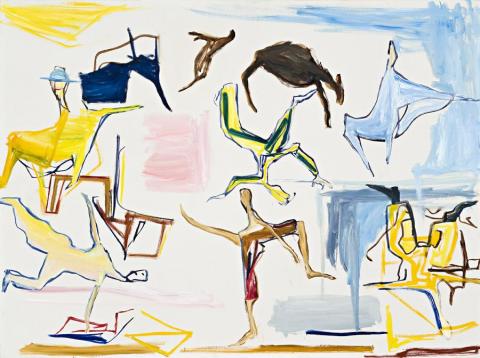DELICATE BALANCE, 1984
Ken Whisson
oil on canvas
88.5 x 118.5 cm
signed, dated and inscribed verso: (in Bilico) /‘Delicate Balance’ / 6 / 10 / 84 / Ken Whisson
inscribed canvas edge verso: Touches of yellow etc./ added 11 / 8 / 85 / ‘In Bilico’ / Delicate Balance / Precarious Balance’ 6 / 10 / 84 [illeg] in fact goes equally well either way Ken Whisson In Bilico’ Delicate Balance 6 / 10 / 84 In Bilico Or ‘Oopla’ 6 / 10 / 84
Watters Gallery, Sydney (label attached verso)
Private collection, Sydney
Deutscher~Menzies, Sydney, 4 March 2003, lot 23
Private collection, Sydney
When looking at a Ken Whisson painting, there is no mistaking this highly enigmatic artist's unique presence. Although the early influences of his teacher Danila Vassilieff and of Albert Tucker are subtly ever present, almost as base-notes in the visual chords Whisson plays, his own composition and distinctive touch sets this artist apart as a truly individual voice.
Whisson's pictures are neither static depictions, nor are they purely gestural abstractions. The works contain a potential energy that is released when a viewer engages and activates the image as forms jostle for position in the ambiguous space created on the canvas. Rejecting classical rules of composition, it may initially seem as if Whisson's paintings are completely chaotic, however, as time passes it becomes clear that his seemingly disordered and intuitive images are held within a sophisticated structure.
As the art critic and author John McDonald explains in his essay, Ken Whisson: Matter and Memory, 'For Whisson, the artist cannot be content with reflecting the patterns imposed on the world by intellect, he must go beyond the ad hoc arrangement and engage with a more fundamental reality. This means adopting a sceptical position vis-à-vis everyday perceptions, asking the viewer to see with the eye of the mind rather than expecting a perfect match between object and representation. In this, the artist asks no more of his audience than he expects of himself: an openness to experience, a willingness to go beyond appearances. To venture a more active interpretation, he celebrates the vital force of the imagination as a way of defying habit and opening a path to perpetual self renewal.'1
But that is not to say that these works are merely random gestures, solely reliant on accidental or haphazard associations. In fact, the 1983-84 series of Circus paintings to which Delicate Balance belongs is based on a firm connection between a specific experience by the artist, and of his reactions to contemporary political events in Europe.
Whisson's visit to Morocco and Marrakech in 1969 was his first encounter with a wholly exotic culture. 'In Marrakech, Whisson experienced some of the most striking contrasts he has ever encountered to the social environment of his youth in Australia. The differences presented themselves in a vivid series of images, colour and sounds: of a maze of small streets; of the movements of clowns, jugglers, musicians and dancers performing daily in the old city. More recently Whisson had been entranced by seeing the Imaginary Circus troupe performing during a trip to London.'2 It was at this time the 1983 Geneva Conference was being held and the debates and positions being expressed there were of great interest to the artist. The combination of these two events gave the artist a vehicle to express his perceptions of the world at the time: of the joy and fear of cultural differences, of beauty and pain within human relationships, and of the notion of our world teetering on a precipice.
'I was thinking about atomic war so much, and nuclear war. Europe was very conscious of it because the Geneva Conference was so obviously a farce, so obviously a front for putting new missiles into Europe, and those missiles are so incredibly dangerous... I had the feeling that there wouldn't be anything to paint any more, but nuclear annihilation... I took to thinking what sort of a world it might be... what human reactions would need to be, if people were going to relate in such a way that they didn't have to bring about wars... Now that we [would] all live together as an enormous family across the whole globe, we might need to relate to each together by entertaining one another. I thought of the world as a great circus - societies, or cities, or towns, or streets... Perhaps we'll have to relate to one another as clowns and acrobats and entertainers if we're going to live together as human beings.'3
Living in Perugia, Italy, since 1977 Whisson is a keen observer of international art and it is within this context that he creates his own work. Since 1952 he has held solo exhibitions in Australia, now regularly exhibiting at Niagara Galleries in Melbourne and Watters Gallery, Sydney. He is represented in numerous major Australian and International public collections.
1. McDonald, J., Ken Whisson: Matter and Memory, introduction to Ken Whisson Paintings 1947 - 1999, Niagara Publishing, Melbourne, 2001, p. 9
2. Murphy, B., Ken Whisson Paintings 1957 - 1985, exhibition catalogue, Broken Hill City Art Gallery, Broken Hill, 1985, p. 22 3. ibid., p. 23
DAMIAN HACKETT
